2010 Alfa Romeo Brera/Spider child restraint
[x] Cancel search: child restraintPage 117 of 271
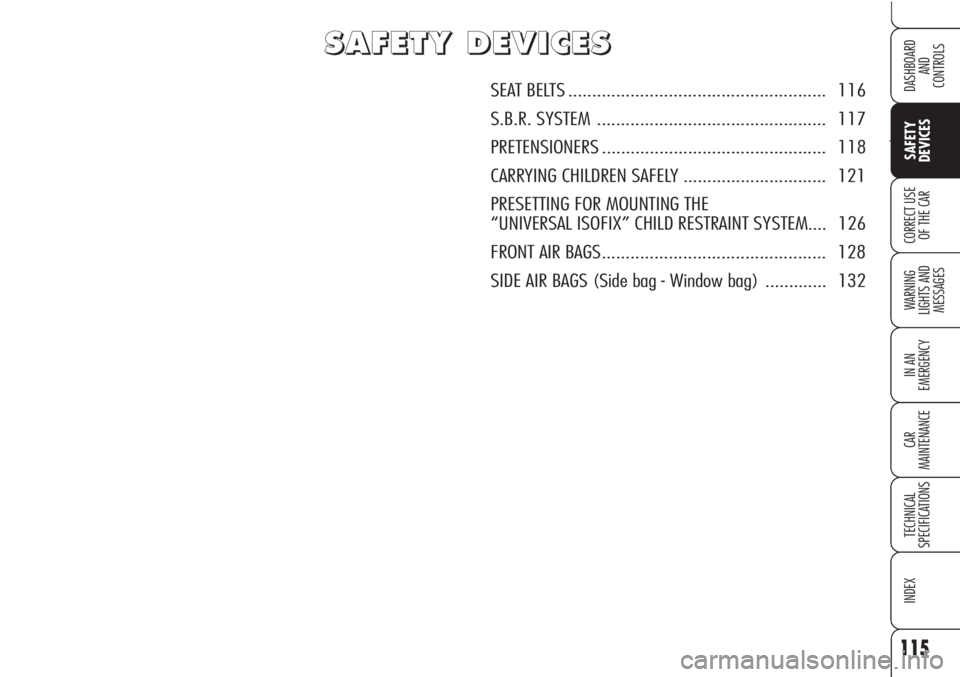
115
Ù
SAFETY
DEVICES
WARNING
LIGHTS AND
MESSAGES
IN AN
EMERGENCY
CAR
MAINTENANCE
TECHNICAL
SPECIFICATIONS
INDEX
DASHBOARD
AND
CONTROLS
CORRECT USE
OF THE CAR
S S
A A
F F
E E
T T
Y Y
D D
E E
V V
I I
C C
E E
S S
SEAT BELTS ...................................................... 116
S.B.R. SYSTEM ................................................ 117
PRETENSIONERS............................................... 118
CARRYING CHILDREN SAFELY .............................. 121
PRESETTING FOR MOUNTING THE
“UNIVERSAL ISOFIX” CHILD RESTRAINT SYSTEM.... 126
FRONT AIR BAGS............................................... 128
SIDE AIR BAGS (Side bag - Window bag) ............. 132
Page 123 of 271

121
Ù
SAFETY
DEVICES
WARNING
LIGHTS AND
MESSAGES
IN AN
EMERGENCY
CAR
MAINTENANCE
TECHNICAL
SPECIFICATIONS
INDEX
DASHBOARD
AND
CONTROLS
CORRECT USE
OF THE CAR
The results of research on the best child
restraint systems are contained in the
European Standard ECE-R44. This Stan-
dard enforces the use of restraint sys-
tems classified in five groups:
Group 0 - 0-10 kg in weight
Group 0+ - 0-13 kg in weight
Group 1 9-18 kg in weight
Group 2 15-25 kg in weight
Group 3 22-36 kg in weight
As it may be noted, the groups overlap
partly and in fact, in commerce it is pos-
sible to find devices that cover more
than one weight group.
All restraint devices must bear the cer-
tification data, together with the control
brand, on a solidly fixed label which
must absolutely never be removed.
Over 1.50 m in height, from the point
of view of restraint systems, children are
considered as adults and wear the seat
belts normally.Lineaccessori Alfa Romeo offers seats for
each weight group, which are the rec-
ommended choice, as they have been
designed and experimented specifical-
ly for Alfa Romeo cars.CARRYING
CHILDREN SAFELY
For optimal protection in the event of
a crash, all passengers must be seated
and wearing adequate restraint systems.
This is even more important for children.
This prescription is compulsory in all EC
countries according to EC Directive
2003/20/EC.
Compared with adults, a child’s head is
proportionately larger and heavier than
the rest of the body, while muscles and
bone structure are not completely de-
veloped. Therefore, in order to restraint
them correctly in the event of a crash,
different systems are needed than adult
seat belts.
With passenger’s air
bag active, never place
child’s seats with the cradle
facing backwards since the air
bag activation could cause to
the child serious injuries, even
mortal, regardless of the seri-
ousness of the crash that trig-
gered it. You are advised to
carry children always with
proper restraint systems on
the rear seats, as this is the
most protected position in the
case of a crash.
WARNING
Page 124 of 271

122
SAFETY
DEVICES
WARNING
LIGHTS AND
MESSAGES
IN AN
EMERGENCY
CAR
MAINTENANCE
TECHNICAL
SPECIFICATIONS
INDEX
DASHBOARD
AND
CONTROLS
CORRECT USE
OF THE CARGROUP 0 and 0+
Babies up to 13 kg must be carried fac-
ing backwards fig. 7on a cradle seat,
which, supporting the head, does not in-
duce stress on the neck in the event of
sharp deceleration.
The cradle is restrained by the car seat
belts and in turn it must restrain the child
with its own belts.
SERIOUS DANGER If it
is absolutely necessary
to carry a child on the
front passenger seat
with the cradle child’s
seat facing backwards, the
front passenger’s air bags
(front air bag, knees air bag,
where provided, and side bag
on seat), must be deactivated
using the key switch (for ver-
sions/markets, where provid-
ed). In this case it is absolute-
ly necessary to check the
warning light
Fon the front
ceiling light panel (see para-
graph “Passenger’s front air
bag”) to make sure that deac-
tivation has actually taken
place. Moreover, the front
passenger’s seat shall be ad-
justed in the most backward
position to prevent any contact
between the child’s seat and
the dashboard.
WARNING
A0F0106mfig. 7
TThe figures are indica-
tive for assembly pur-
poses only. To install the child
restraint, refer to the instruc-
tions supplied with the same.
Child seats with Isofix attach-
ments are available for a safe
anchoring to the seat without
using the car seat belts.
WARNING
A0F0106mfig. 8
GROUP 1 fig. 8
Starting from 9 kg to 18 kg in weight,
children may be carried facing forwards.
Page 126 of 271

124
SAFETY
DEVICES
WARNING
LIGHTS AND
MESSAGES
IN AN
EMERGENCY
CAR
MAINTENANCE
TECHNICAL
SPECIFICATIONS
INDEX
DASHBOARD
AND
CONTROLS
CORRECT USE
OF THE CAR
SUITABILITY OF PASSENGER SEATS FOR CHILD SEAT USE
Your car complies with the new European Directive 2000/3/EC regulating child’s seat assembling on the different car seats
according to the following tables:
Front and rear seat
SEAT
Group Range of weight Front Rear side
Seat with Seat with Rear
4 positions 8 positions passenger
Group 0, 0+ up to 13 kg U (*) U (*) U
Group 1 9-18 kg U (*) U (*) U
Group 2 15-25 kg U (*) U (*) U
Group 3 22-36 kg U (*) U (*) U
Key:
U= suitable for child restraint systems of the “Universal” category, according to European Standard EEC-R44 for the specified “Groups”.
(*) = on cars not fitted with passenger’s seat adjustable in height, the seat back shall be positioned perfectly upright. On cars fitted with
passenger’s seat adjustable in height, the seat shall be raised as much as possible.
Page 127 of 271
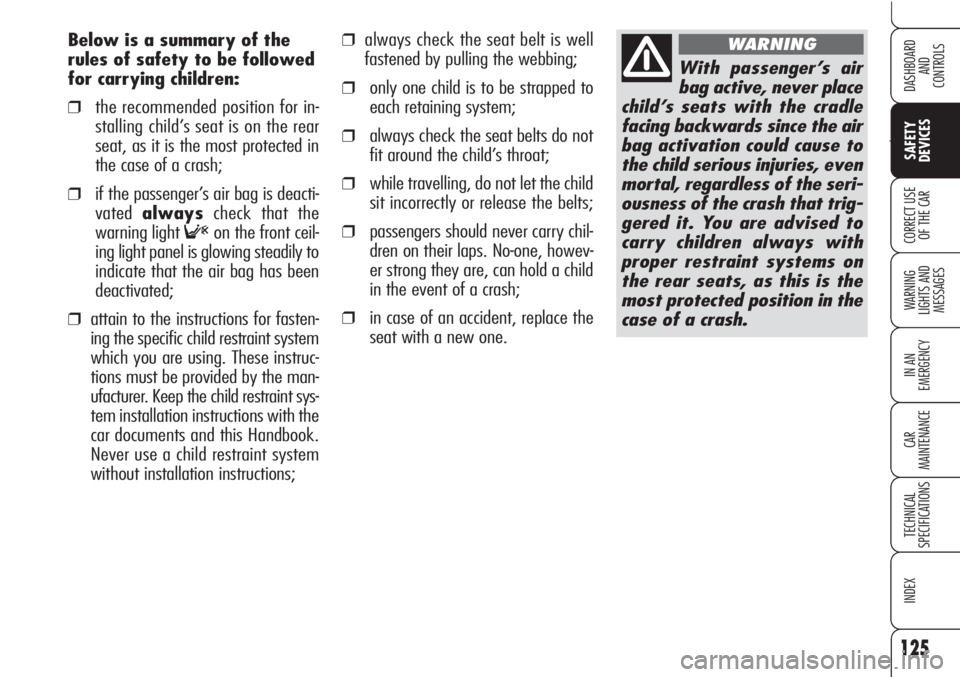
125
Ù
SAFETY
DEVICES
WARNING
LIGHTS AND
MESSAGES
IN AN
EMERGENCY
CAR
MAINTENANCE
TECHNICAL
SPECIFICATIONS
INDEX
DASHBOARD
AND
CONTROLS
CORRECT USE
OF THE CAR
❒always check the seat belt is well
fastened by pulling the webbing;
❒only one child is to be strapped to
each retaining system;
❒always check the seat belts do not
fit around the child’s throat;
❒while travelling, do not let the child
sit incorrectly or release the belts;
❒passengers should never carry chil-
dren on their laps. No-one, howev-
er strong they are, can hold a child
in the event of a crash;
❒in case of an accident, replace the
seat with a new one. Below is a summary of the
rules of safety to be followed
for carrying children:
❒the recommended position for in-
stalling child’s seat is on the rear
seat, as it is the most protected in
the case of a crash;
❒if the passenger’s air bag is deacti-
vatedalwayscheck that the
warning light
Fon the front ceil-
ing light panel is glowing steadily to
indicate that the air bag has been
deactivated;
❒attain to the instructions for fasten-
ing the specific child restraint system
which you are using. These instruc-
tions must be provided by the man-
ufacturer. Keep the child restraint sys-
tem installation instructions with the
car documents and this Handbook.
Never use a child restraint system
without installation instructions;
With passenger’s air
bag active, never place
child’s seats with the cradle
facing backwards since the air
bag activation could cause to
the child serious injuries, even
mortal, regardless of the seri-
ousness of the crash that trig-
gered it. You are advised to
carry children always with
proper restraint systems on
the rear seats, as this is the
most protected position in the
case of a crash.
WARNING
Page 128 of 271
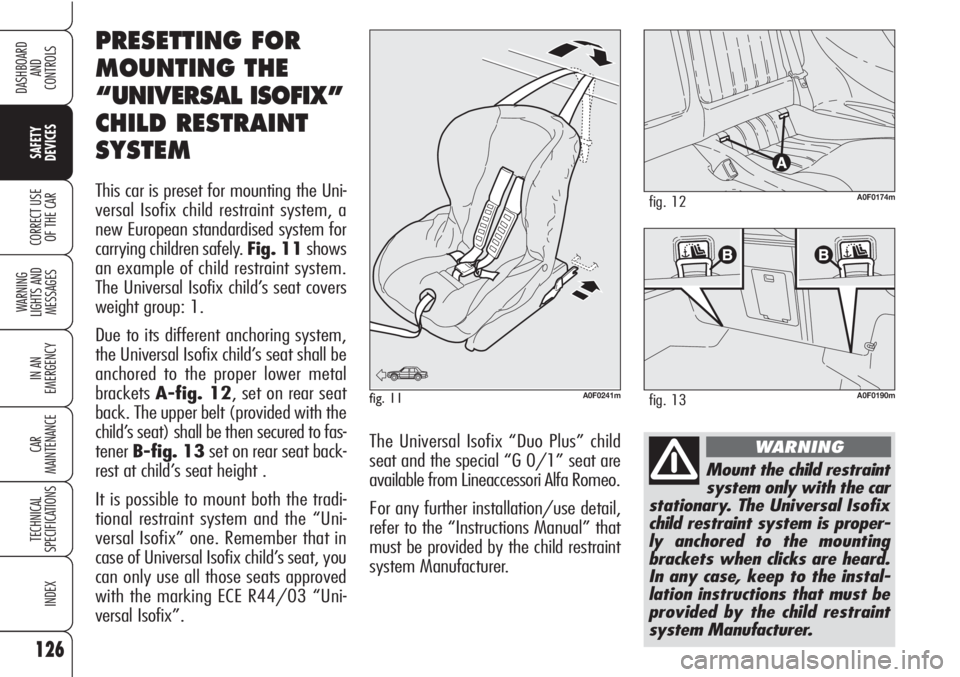
126
SAFETY
DEVICES
WARNING
LIGHTS AND
MESSAGES
IN AN
EMERGENCY
CAR
MAINTENANCE
TECHNICAL
SPECIFICATIONS
INDEX
DASHBOARD
AND
CONTROLS
CORRECT USE
OF THE CAR
Mount the child restraint
system only with the car
stationary. The Universal Isofix
child restraint system is proper-
ly anchored to the mounting
brackets when clicks are heard.
In any case, keep to the instal-
lation instructions that must be
provided by the child restraint
system Manufacturer.
WARNING
PRESETTING FOR
MOUNTING THE
“UNIVERSAL ISOFIX”
CHILD RESTRAINT
SYSTEM
This car is preset for mounting the Uni-
versal Isofix child restraint system, a
new European standardised system for
carrying children safely. Fig. 11shows
an example of child restraint system.
The Universal Isofix child’s seat covers
weight group: 1.
Due to its different anchoring system,
the Universal Isofix child’s seat shall be
anchored to the proper lower metal
bracketsA-fig. 12, set on rear seat
back. The upper belt (provided with the
child’s seat) shall be then secured to fas-
tenerB-fig. 13set on rear seat back-
rest at child’s seat height .
It is possible to mount both the tradi-
tional restraint system and the “Uni-
versal Isofix” one. Remember that in
case of Universal Isofix child’s seat, you
can only use all those seats approved
with the marking ECE R44/03 “Uni-
versal Isofix”.The Universal Isofix “Duo Plus” child
seat and the special “G 0/1” seat are
available from Lineaccessori Alfa Romeo.
For any further installation/use detail,
refer to the “Instructions Manual” that
must be provided by the child restraint
system Manufacturer.A0F0174mfig. 12
fig. 11A0F0241mA0F0190mfig. 13
Page 129 of 271
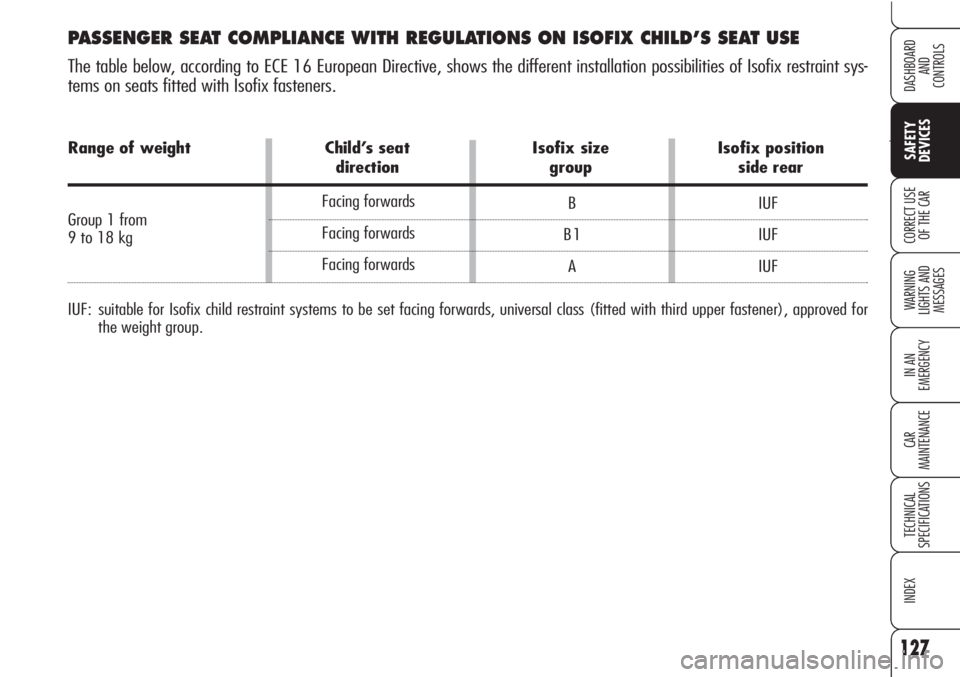
Range of weight Child’s seat Isofix size Isofix position
direction group side rear
Group 1 from
9 to 18 kg
127
Ù
SAFETY
DEVICES
WARNING
LIGHTS AND
MESSAGES
IN AN
EMERGENCY
CAR
MAINTENANCE
TECHNICAL
SPECIFICATIONS
INDEX
DASHBOARD
AND
CONTROLS
CORRECT USE
OF THE CAR
IUF: suitable for Isofix child restraint systems to be set facing forwards, universal class (fitted with third upper fastener), approved for
the weight group.
PASSENGER SEAT COMPLIANCE WITH REGULATIONS ON ISOFIX CHILD’S SEAT USE
The table below, according to ECE 16 European Directive, shows the different installation possibilities of Isofix restraint sys-
tems on seats fitted with Isofix fasteners.
B
B1
AIUF
IUF
IUF Facing forwards
Facing forwards
Facing forwards
Page 134 of 271
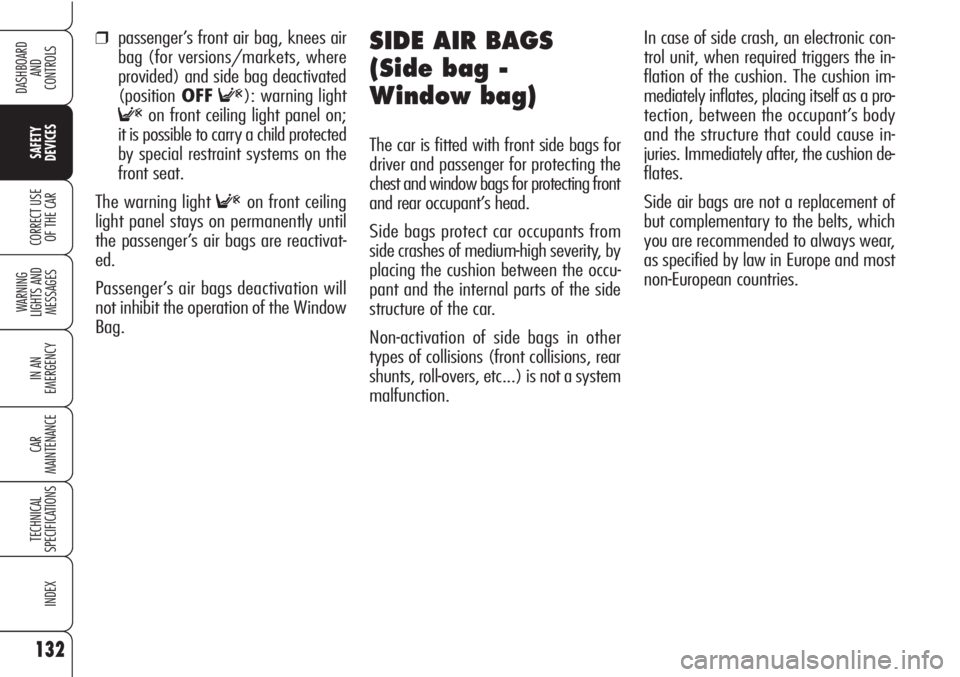
132
SAFETY
DEVICES
WARNING
LIGHTS AND
MESSAGES
IN AN
EMERGENCY
CAR
MAINTENANCE
TECHNICAL
SPECIFICATIONS
INDEX
DASHBOARD
AND
CONTROLS
CORRECT USE
OF THE CAR
❒passenger’s front air bag, knees air
bag (for versions/markets, where
provided) and side bag deactivated
(positionOFF
F): warning light
Fon front ceiling light panel on;
it is possible to carry a child protected
by special restraint systems on the
front seat.
The warning light
Fon front ceiling
light panel stays on permanently until
the passenger’s air bags are reactivat-
ed.
Passenger’s air bags deactivation will
not inhibit the operation of the Window
Bag.
SIDE AIR BAGS
(Side bag -
Window bag)
The car is fitted with front side bags for
driver and passenger for protecting the
chest and window bags for protecting front
and rear occupant’s head.
Side bags protect car occupants from
side crashes of medium-high severity, by
placing the cushion between the occu-
pant and the internal parts of the side
structure of the car.
Non-activation of side bags in other
types of collisions (front collisions, rear
shunts, roll-overs, etc...) is not a system
malfunction.In case of side crash, an electronic con-
trol unit, when required triggers the in-
flation of the cushion. The cushion im-
mediately inflates, placing itself as a pro-
tection, between the occupant’s body
and the structure that could cause in-
juries. Immediately after, the cushion de-
flates.
Side air bags are not a replacement of
but complementary to the belts, which
you are recommended to always wear,
as specified by law in Europe and most
non-European countries.